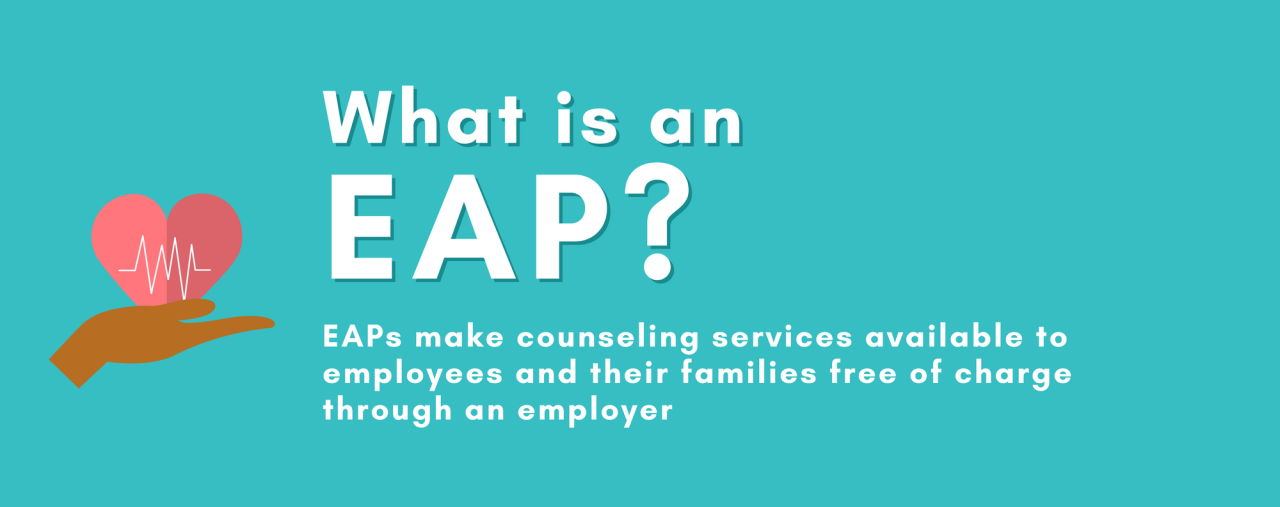In today’s fast-paced and demanding work environment, employee well-being is no longer just a nice-to-have, it’s a necessity. Enter EAP insurance, a powerful tool that empowers both employers and employees to navigate the complexities of modern life. This insurance goes beyond traditional healthcare, offering a comprehensive suite of services designed to support mental, emotional, and financial health. From confidential counseling to work-life balance programs, EAP insurance provides a safety net for employees facing personal challenges, ultimately boosting productivity and fostering a more engaged workforce.
But EAP insurance isn’t just about employee benefits, it’s a strategic investment for businesses. By proactively addressing employee well-being, companies can mitigate absenteeism, reduce turnover, and create a more positive and productive work environment. This article delves into the intricacies of EAP insurance, exploring its benefits for both employers and employees, and highlighting the crucial role it plays in shaping a healthier and more resilient workforce.
What is EAP Insurance?

Employee Assistance Programs (EAPs) are a type of insurance that provides confidential support services to employees facing personal or work-related challenges. They are designed to promote employee well-being, improve productivity, and reduce absenteeism. EAPs are often offered as a benefit to employees by their employers.
Purpose of EAP Insurance
EAP insurance aims to provide a safety net for employees by offering access to confidential support services that can help them navigate various personal and work-related issues. These services are typically provided by trained professionals who can offer guidance, counseling, and resources to help employees overcome challenges and maintain their well-being.
Role of EAP Insurance in Employee Well-being
EAP insurance plays a crucial role in promoting employee well-being by providing access to confidential support services. By offering these services, EAPs aim to address issues that may be impacting an employee’s mental, emotional, or physical health, which can, in turn, lead to improved job satisfaction, reduced stress levels, and enhanced productivity.
Types of Services Offered by EAP Programs
EAP programs typically offer a wide range of services designed to address various personal and work-related challenges. These services can include:
- Counseling: EAPs provide access to professional counselors who can help employees cope with a wide range of issues, such as stress, anxiety, depression, relationship problems, and substance abuse.
- Work-Life Balance Support: EAPs can assist employees with managing work-life balance challenges, such as childcare, eldercare, and financial planning.
- Legal and Financial Assistance: EAPs may provide legal and financial counseling to employees facing legal or financial issues.
- Crisis Intervention: EAPs can provide immediate support to employees experiencing a crisis, such as a traumatic event or a mental health emergency.
- Employee Wellness Programs: EAPs may offer programs designed to promote employee health and well-being, such as fitness classes, health screenings, and smoking cessation programs.
Benefits of EAP Insurance for Employers
Employee Assistance Programs (EAPs) offer a range of services designed to support employee well-being and address personal and work-related challenges. For employers, EAPs are a valuable investment that can lead to significant improvements in productivity, employee retention, and overall workplace culture.
Improved Employee Productivity and Reduced Absenteeism
EAPs play a crucial role in enhancing employee productivity by addressing factors that contribute to absenteeism and reduced performance.
- Stress Management: EAPs provide resources for stress management techniques, helping employees cope with work-related stressors and improve their ability to focus and perform at their best. Studies have shown that workplace stress can significantly impact productivity and lead to increased absenteeism.
- Work-Life Balance: EAPs offer guidance and support to help employees achieve a healthy work-life balance, reducing burnout and enhancing overall well-being. By addressing work-life balance issues, EAPs can improve employee morale and reduce absenteeism due to personal or family concerns.
- Mental Health Support: EAPs provide access to mental health professionals who can offer counseling, therapy, and support for employees facing mental health challenges. Addressing mental health issues early can prevent them from escalating and impacting work performance.
Cost Savings Associated with EAP Programs
EAPs can deliver significant cost savings for employers through various mechanisms:
- Reduced Absenteeism: By addressing the root causes of absenteeism, EAPs can lead to a decrease in employee absences, resulting in lower costs associated with sick leave and temporary replacements. A study by the Employee Assistance Professionals Association (EAPA) found that EAPs can reduce absenteeism by up to 20%.
- Improved Employee Retention: EAPs contribute to a positive work environment and employee well-being, increasing employee satisfaction and retention. High employee turnover can be costly, involving recruitment, training, and lost productivity.
- Reduced Workers’ Compensation Claims: EAPs can help prevent and manage workplace injuries and illnesses by addressing factors such as stress, burnout, and mental health issues. This can lead to a reduction in workers’ compensation claims, saving employers significant costs.
Benefits of EAP Insurance for Employees

EAP insurance offers a valuable resource for employees, providing access to confidential support services that can enhance their mental health and well-being. These programs go beyond traditional healthcare benefits by offering a holistic approach to employee well-being.
Support for Mental Health and Well-being
EAP programs play a crucial role in promoting employee mental health by offering confidential access to qualified professionals. This includes licensed therapists, counselors, and psychiatrists who can provide a wide range of services tailored to individual needs. These services can address various mental health concerns, such as anxiety, depression, stress, and relationship issues.
Examples of EAP Services
EAP programs typically offer a comprehensive range of services to support employee well-being. Some common examples include:
- Short-term counseling: Employees can access a limited number of counseling sessions with licensed professionals to address personal or work-related challenges. This can help individuals develop coping mechanisms, improve communication skills, and enhance their overall mental health.
- Crisis intervention: EAP programs provide immediate support for employees experiencing a crisis, such as a personal loss, family emergency, or workplace conflict. Trained professionals can offer guidance, resources, and referrals to appropriate services.
- Work-life balance resources: EAP programs often offer services to help employees manage work-life balance, including financial counseling, legal assistance, and childcare referral services. These resources can alleviate stress and provide practical support to navigate life’s challenges.
- Substance abuse support: EAP programs may offer resources and referrals for employees struggling with substance abuse. This can include assessments, counseling, and access to treatment programs.
Confidentiality and Privacy
Confidentiality and privacy are paramount in EAP programs. Employees can access services without fear of repercussions or disclosure of their personal information. This ensures that individuals feel comfortable seeking help without concerns about their privacy being compromised.
EAP programs adhere to strict confidentiality guidelines, ensuring that employee information is protected and only shared with authorized individuals.
Common EAP Services
EAP programs offer a wide range of services designed to support employees and their families in various aspects of their well-being. These services are typically confidential and accessible to all employees and their dependents, regardless of their position or tenure within the company.
Types of EAP Services
| Service | Description | Example | Benefit |
|---|---|---|---|
| Counseling | Provides individual, family, or group therapy sessions to address mental health concerns, relationship issues, stress management, and other personal challenges. | A manager experiencing burnout and struggling with work-life balance can seek counseling to develop coping mechanisms and improve their well-being. | Improved mental health, reduced stress, enhanced productivity, and better work-life balance. |
| Legal Assistance | Offers legal advice and representation for legal matters related to employment, family, and personal life. | An employee facing a legal dispute with a landlord can access legal assistance to understand their rights and options. | Reduced legal stress and anxiety, improved legal outcomes, and enhanced employee peace of mind. |
| Financial Planning | Provides guidance on financial matters, such as budgeting, debt management, and retirement planning. | An employee struggling with debt can receive financial counseling to develop a budget, explore debt consolidation options, and improve their financial stability. | Improved financial literacy, reduced financial stress, and enhanced financial security. |
| Work-Life Balance Support | Offers resources and support to help employees manage work-life demands, including childcare, eldercare, and other personal responsibilities. | An employee with a sick child can access resources for finding temporary childcare or connecting with support groups for parents. | Improved work-life balance, reduced stress, and enhanced employee well-being. |
| Substance Abuse Treatment | Provides confidential assessment, referral, and treatment for substance abuse issues, including alcohol and drug addiction. | An employee struggling with alcohol dependence can receive confidential assessment and referral to appropriate treatment programs. | Reduced substance abuse, improved health and well-being, and enhanced work performance. |
Eligibility and Access to EAP Programs

EAP programs are typically available to employees of participating organizations. These programs are often offered as a benefit to all employees, regardless of their job title or length of service. However, some programs may have specific eligibility criteria, such as requiring a minimum number of hours worked per week or a certain period of employment.
Eligibility for EAP Services
Employees become eligible for EAP services by being employed by a company that offers an EAP program. The program’s eligibility criteria may vary depending on the employer’s policy.
For instance, some employers may require employees to have worked for a specific duration before they can access EAP services.
The employer usually provides information about the EAP program to employees during onboarding or through employee handbooks.
Access Methods for EAP Programs
EAP programs typically provide employees with multiple ways to access their services. The most common access methods include:
- Telephone Hotline: This is the most traditional and often the first point of contact for employees seeking assistance. EAPs typically have 24/7 telephone lines staffed by trained professionals who can provide immediate support and guidance.
- Website: Many EAP programs have dedicated websites where employees can find information about the program, access resources, and schedule appointments. These websites often offer online self-assessment tools, articles, and videos on various topics related to mental health and well-being.
- Mobile Apps: Some EAPs have developed mobile apps that provide employees with convenient access to services on their smartphones or tablets. These apps may offer features like confidential journaling, self-help resources, and the ability to connect with EAP counselors through secure messaging.
Limitations and Restrictions on EAP Program Usage
While EAP programs offer a wide range of services, there are typically some limitations or restrictions on their usage. These may include:
- Number of Sessions: Most EAP programs offer a limited number of counseling sessions per year. The exact number of sessions allowed varies depending on the program. However, some EAPs may provide additional sessions in certain circumstances, such as for crisis intervention or when a longer-term treatment plan is required.
- Types of Issues: EAP programs generally focus on work-life issues, mental health concerns, and substance abuse. While they can provide support for other personal issues, their scope is often limited to those that have a direct impact on the employee’s work performance or well-being.
- Confidentiality: EAP services are generally confidential, meaning that information shared with EAP counselors is not typically disclosed to the employer. However, there are some exceptions to this rule, such as in cases where there is a threat of harm to the employee or others. Employees should be aware of the confidentiality policies of their specific EAP program.
Cost and Funding of EAP Programs
The cost of EAP insurance is a significant factor for employers considering implementing such a program. Understanding the typical costs and funding models is crucial for making informed decisions.
EAP programs are generally priced based on the number of employees covered. Costs can vary widely depending on the size of the company, the scope of services offered, and the specific features included in the program.
Typical Costs of EAP Programs
The cost of EAP programs for employers can range from a few dollars per employee per month to several dollars per employee per month. Smaller companies with fewer employees may have a higher per-employee cost, while larger companies may benefit from volume discounts.
- The average cost of an EAP program is around $10-$20 per employee per month, but this can vary significantly.
- Smaller companies with fewer than 50 employees may pay around $25-$30 per employee per month.
- Larger companies with more than 500 employees may pay as little as $5-$10 per employee per month.
Funding Models for EAP Programs
Employers have several options for funding EAP programs:
- Employer-sponsored plans: The most common funding model, where the employer fully covers the cost of the EAP program for their employees. This can be a significant investment for employers, but it demonstrates a commitment to employee well-being and can help to reduce costs associated with absenteeism and turnover.
- Employee contributions: Some employers may require employees to contribute a portion of the cost of the EAP program. This can help to reduce the employer’s financial burden, but it may also discourage some employees from using the program.
- Combined funding: Some employers may opt for a combined funding model, where both the employer and employees contribute to the cost of the EAP program. This can be a good compromise that balances the interests of both parties.
Factors Influencing EAP Costs
Several factors can influence the cost of EAP insurance:
- Number of employees: The number of employees covered by the EAP program is a major factor in determining the cost. Larger companies with more employees will typically pay a lower per-employee cost than smaller companies.
- Scope of services: The range of services offered by the EAP program can also impact the cost. Programs with a wider range of services, such as financial counseling or legal assistance, will generally be more expensive than programs that only offer basic counseling services.
- Geographic location: The cost of EAP programs can vary depending on the geographic location of the company. For example, EAP programs in major metropolitan areas may be more expensive than programs in rural areas.
- Utilization rate: The utilization rate of the EAP program, or the number of employees who use the program, can also influence the cost. Programs with high utilization rates may be more expensive, as they require more resources to provide services to employees.
Importance of Confidentiality and Privacy

Employee Assistance Programs (EAPs) are designed to provide confidential support and resources to employees facing personal and work-related challenges. Confidentiality and privacy are paramount to the effectiveness of EAP programs, ensuring that employees feel comfortable seeking help without fear of judgment or repercussions.
EAP programs are built on a foundation of trust and anonymity, safeguarding the privacy of employees who access their services. This commitment to confidentiality is crucial for promoting open communication and encouraging employees to seek help when they need it most.
Protection of Employee Information
EAP programs employ stringent measures to protect the confidentiality of employee information. This includes:
- Separate and Secure Records: EAP records are kept separate from the employer’s personnel files, ensuring that access to employee information is restricted to authorized EAP personnel. This separation helps protect sensitive data from unauthorized disclosure.
- Limited Access and Sharing: Access to EAP records is limited to qualified EAP professionals, and information is shared only with the employee’s consent. This ensures that employee information is not disclosed without their knowledge or permission.
- Confidentiality Agreements: EAP providers and staff are bound by strict confidentiality agreements, prohibiting them from disclosing any information about an employee’s participation in the program. These agreements ensure that employee information is protected even in the event of legal proceedings or investigations.
Anonymity and Confidentiality
EAP programs prioritize anonymity, allowing employees to seek help without revealing their identity to their employer. This is achieved through:
- Confidential Access: EAP programs can be accessed through a dedicated phone line, website, or mobile app, allowing employees to reach out without disclosing their identity to anyone at their workplace.
- Anonymous Counseling Sessions: Counseling sessions can be conducted over the phone, video conferencing, or in person at a neutral location, ensuring that the employee’s identity remains confidential.
- No Records in Personnel Files: EAP records are not kept in employee personnel files, ensuring that their participation in the program remains confidential from their employer.
Ethical Considerations
The handling of sensitive employee data within EAP programs requires careful consideration of ethical principles. This includes:
- Informed Consent: Employees must be informed about the confidentiality and privacy policies of the EAP program before accessing its services. This ensures that they are aware of how their information will be handled and have the opportunity to provide informed consent.
- Data Security: EAP programs are responsible for implementing robust data security measures to protect employee information from unauthorized access, use, or disclosure. This includes using secure data storage, encryption, and access control mechanisms.
- Transparency and Accountability: EAP programs should be transparent about their confidentiality and privacy practices and be accountable for adhering to ethical standards. This includes providing employees with clear information about their rights and responsibilities related to data privacy.
Examples of EAP Programs in Action
EAP programs are not theoretical constructs; they have a tangible impact on both employees and organizations. Numerous real-world examples demonstrate their effectiveness in improving employee well-being, boosting productivity, and fostering a healthier work environment.
Successful EAP Implementations
Real-world examples showcase the effectiveness of EAP programs. For instance, a study by the American Psychological Association found that EAPs can lead to a significant reduction in absenteeism and presenteeism, saving organizations millions of dollars annually. This is because EAPs address the root causes of employee stress and burnout, enabling them to be more engaged and productive.
Positive Impact on Employees and Organizations
EAPs can positively impact both employees and organizations. For employees, EAPs provide confidential support and resources to address personal and work-related issues, leading to improved mental health, reduced stress, and enhanced job satisfaction. For organizations, EAPs can contribute to a more productive workforce, lower absenteeism and turnover rates, and a more positive work environment.
Case Studies and Research Findings
Research consistently demonstrates the effectiveness of EAP programs. A study by the Employee Assistance Professionals Association found that EAPs can lead to a significant return on investment for organizations. For every dollar spent on EAP services, organizations can expect to save an average of $5 in reduced costs related to absenteeism, presenteeism, and turnover.
“EAPs are a valuable investment for organizations. They can help to improve employee well-being, reduce absenteeism and presenteeism, and foster a more positive work environment.” – Employee Assistance Professionals Association
Examples of EAP Services in Action
- Stress Management: An EAP program at a technology company implemented a stress management workshop for employees. The workshop provided practical strategies for coping with stress, such as mindfulness techniques, time management skills, and healthy lifestyle habits. The program resulted in a significant reduction in employee stress levels and improved productivity.
- Work-Life Balance: A financial services company implemented an EAP program that included work-life balance counseling. Employees struggling to manage work and family responsibilities were able to access confidential counseling and resources to develop strategies for better managing their time and priorities. This led to improved employee morale and reduced absenteeism.
- Substance Abuse: A healthcare organization implemented an EAP program that provided confidential substance abuse assessment and treatment services to employees. The program helped employees struggling with addiction to access the support and resources they needed to recover, leading to improved employee health and reduced workplace accidents.
Future Trends in EAP Insurance
Employee Assistance Programs (EAPs) are evolving rapidly, driven by changing workplace dynamics, technological advancements, and a growing focus on employee well-being. These trends are shaping the future of EAP insurance, leading to more comprehensive, accessible, and personalized programs.
Integration with Technology
Technology is transforming the way EAPs are delivered and accessed.
- Mobile-first platforms are making EAP services readily available to employees anytime, anywhere.
- AI-powered chatbots and virtual assistants are providing 24/7 support and initial assessments.
- Data analytics is enabling EAP providers to identify patterns and trends in employee needs, allowing for targeted interventions and program improvements.
Expansion of Services
EAPs are expanding beyond traditional counseling and support services.
- Mental health awareness and prevention programs are being integrated into EAPs to promote proactive well-being.
- Financial wellness services are gaining prominence, addressing issues like debt management and financial planning.
- Work-life balance resources are being incorporated to help employees navigate the demands of work and personal life.
Personalized EAPs
Tailored EAP programs are becoming increasingly common, recognizing the diverse needs of employees.
- Employee demographics, work roles, and individual preferences are being considered in program design.
- EAP providers are offering specialized services for specific populations, such as millennials, remote workers, or those with specific health conditions.
Focus on Prevention
The focus is shifting from reactive crisis management to proactive prevention.
- EAPs are increasingly investing in preventive programs that address workplace stress, burnout, and mental health issues before they escalate.
- Early intervention strategies are being implemented to identify and support employees at risk of developing mental health challenges.
Data-Driven Insights
Data analytics is playing a crucial role in understanding EAP effectiveness and improving program outcomes.
- EAP providers are leveraging data to track program utilization, identify trends, and measure the impact of interventions.
- This data-driven approach allows for continuous improvement and optimization of EAP services.
Increased Integration with Other Benefits
EAPs are becoming more integrated with other employee benefits, creating a holistic approach to well-being.
- Integration with health insurance plans allows for seamless access to mental health services.
- Collaboration with other employee benefits programs, such as wellness programs, can enhance overall well-being initiatives.
Emerging Trends
- Virtual Reality (VR) Therapy: EAPs are exploring the use of VR technology to provide immersive and interactive therapeutic experiences.
- Wearable Technology: EAPs are exploring the use of wearable technology to monitor employee well-being and identify potential stress or health issues.
- Artificial Intelligence (AI): AI-powered tools are being used to personalize EAP services, provide automated support, and analyze data for insights.
Final Thoughts
EAP insurance is more than just a benefit, it’s a vital investment in a company’s most valuable asset: its people. By prioritizing employee well-being, businesses can unlock a wealth of benefits, from improved productivity and reduced absenteeism to increased employee engagement and loyalty. As EAP programs continue to evolve and adapt to the changing needs of the workforce, their impact on both individuals and organizations will only grow stronger, solidifying their position as an essential component of a thriving and sustainable business model.

